Pheidole sculpturata Mayr

 Iran list Iran list
 Type location South
Africa (Pheidole
sculpturata nov. spec., Mayr, 1866b: 897, major; Emery, 1895h:
31, minor) - see below Type location South
Africa (Pheidole
sculpturata nov. spec., Mayr, 1866b: 897, major; Emery, 1895h:
31, minor) - see below
junior synonyms (status here)
areolata (Pheidole
sculpturata Mayr var. areolata n. var., Forel,
1911e: 269, major & minor), from South Africa, Bothaville,
Orange State, collected by Dr Brauns - see below (apparently
mislabelled as from "Liberia")
berthoudi (Pheidole
sculpturata Mayr, r. Berthoudi
n. stirps, Forel, 1894b: 89, major & minor; raised to species by
Santschi, 1921f, subspecies of sculpturata
in Emery, 1921f: 89) from South Africa,
Valdezia, Transvaal, collector Rev Paul Berthoud - see http://www.antweb.org/specimenImages.do?code=casent0249068
rhodesiana (Pheidole excellens Mayr r. rhodesiana
n. st., Forel,
1913a: 131, major & minor; Arnold, 1920a: 470, male; stirps of sculpturata,
Santschi, 1930b: 63, footnote) from Zimbabwe, Bulawayo,
collector Arnold - see http://www.antweb.org/specimenImages.do?code=casent0249062
reddenburgensis (Ph.
(Allopheidole) cuitensis For. r. reddenburgensis n. st.,
Forel, 1913a: 135, all forms; subspecies of capensis by Emery,
1915j: 246) from South Africa - see below - added here
subspecies
particeps (Pheidole
Berthoudi For. var. particeps
nov. var., Santschi, 1921c: 116, minor) from Tanzania,
collected at Bukoba, by Viehmeyer - see linked page  . .
|
Mayr's (1866b) description is at  . Emery's (1895h) description of the minor
is at . Emery's (1895h) description of the minor
is at  . Arnold (1920a: 461) gave an illustrated
translation and notes on the minor, this is at . Arnold (1920a: 461) gave an illustrated
translation and notes on the minor, this is at  . Forel's (1894b) description of berthoudi
is at . Forel's (1894b) description of berthoudi
is at  . Forel's (1911e)
description of areolata is at . Forel's (1911e)
description of areolata is at  . Santschi's (1921c) description of particeps
is at . Santschi's (1921c) description of particeps
is at  . Forel's (1913a)
description of rhodesiana is at . Forel's (1913a)
description of rhodesiana is at  . Arnold (1920a: 469)
gave an illustrated translation of rhodesiana, this is at . Arnold (1920a: 469)
gave an illustrated translation of rhodesiana, this is at  . Arnold (1920a: 463) gave translations of areolata
and berthoudi, these are at . Arnold (1920a: 463) gave translations of areolata
and berthoudi, these are at  . Forel's (1913a) description of reddenburgensis
is at . Forel's (1913a) description of reddenburgensis
is at  . Arnold (1920a: 450)
gave an illustrated translation, this is at . Arnold (1920a: 450)
gave an illustrated translation, this is at  and and  . .
|
I have created a separate page for the clearly different
Pheidole sculpturata particeps.
Although Santschi described it as a form of P. berthoudi the type images show
that to be identical to the type sculpturata.
I have separated the
quite dramatically different Pheidole welgelegensis as a
distinct species, even though I had only the minor workers. I suspect
the records from
West Africa and the Congo Basin were mostly, if not all, of welgelegenensis.. Similarly also
very different is the small species Pheidole
zambesiana, TL ca 4.8 mm, which lacks erect pilosity.
|
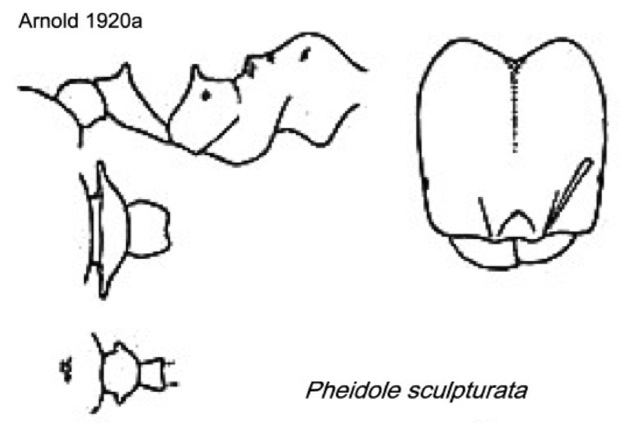 It
is very clear, however, that there is real and wide variation between
the described forms, as follows. Without images of the Mayr types, it
is not possible usefully clarify the situation. It
is very clear, however, that there is real and wide variation between
the described forms, as follows. Without images of the Mayr types, it
is not possible usefully clarify the situation.
I have derived sizes of Antweb images specimens by
assuming the accuracy of the Antweb scales, with the suspicion that the
automontage
process sometimes distorts the shapes, specially in full
face view of what after all is not a flat object.,
Mayr gave the size as major - TL 9.5 mm, HL 3.8 (Arnold
added HW 2.8); minor TL 3.0-3.2 mm. Emery (1895h) described the major
of a "simple variety" as TL no more than 8 mm, HL 3.5, HW 2.6; minor TL
3.0 mm.
Forel (1911e) described areolata, the major he
gave as TL 8 mm, HL 3, HW 2.6-2.7. The minor was TL 2.8 mm. From
Bothaville, Orange Free State, by Dr Brauns.
Note: The
specimens from the Antweb images and bearing the labels areolata typus
are from Liberia and so are not the true types. These have major TL ca
6.7 mm, HL 2.4, HW 2.0; minor TL ca 2.5 mm, HL 0.64, HW 0.6.
(types shown below). They, however, are a close match in size and form
to the types of dignata
Forel (1909b) noted that Creighton Wellman collected
specimens of berthoudi tending aphids in Benguela; TL of major
5.3-6.0 mm; minor TL 3.2 mm.
Forel (1913a) had rhodesiana
as major TL 7.0 mm, HL 3.3, HW 2.2; minor TL 3.0 mm. He gave zambesiana as major TL 6.0 mm;
minor TL 2.4 mm. These sizes match the Antweb scale sizes on the rhodesiana images.
Santschi (1921c) gave particeps
minor as TL 3.2-3.5 mm.
Major and minor specimens from Botswana identified by B
Bolton are shown at the bottom and, apart from very minor differences
in sculpturation, are very similar to those I have. They are smaller,
however, smaller with TL ca 7.0 mm, HL2.2, HW 1.92; minor TL ca 3.3 mm,
HL 0.91 HW 0.82.
The Ethiopia specimens (shown below) that I have are:
major TL ca 9.5 mm, HL 3.1, HW 3.0; minor TL ca 3.8 mm, HL 1.1,
HW 0.9.
Minors
with the body very matt, and head near square (after Bernard, 1952).
Collingwood & Agosti (1996) denote it as separable from teneriffana
by the postpetiole being as three times as wide as
long, and, the head with the median occipital area smooth. Legs and
antennae clothed with erect pubescence. Note - they separated katonae
as a separate species, in which the appendages have decumbent
pubescence and the head sculpturation is weak and stated the earlier
reference to sculpturata (by Collingwood, 1985) was an error.
|
 Unusual in
having polymorphic workers, which led Forel
(1913a) to suggest a new subgenus Allopheidole. Arnold (1920a)
tried to have the name altered to reddersburgensis, so as to
accurately reflect the type location, but this was not accepted by
Wheeler (1922: 809). Unusual in
having polymorphic workers, which led Forel
(1913a) to suggest a new subgenus Allopheidole. Arnold (1920a)
tried to have the name altered to reddersburgensis, so as to
accurately reflect the type location, but this was not accepted by
Wheeler (1922: 809).
|
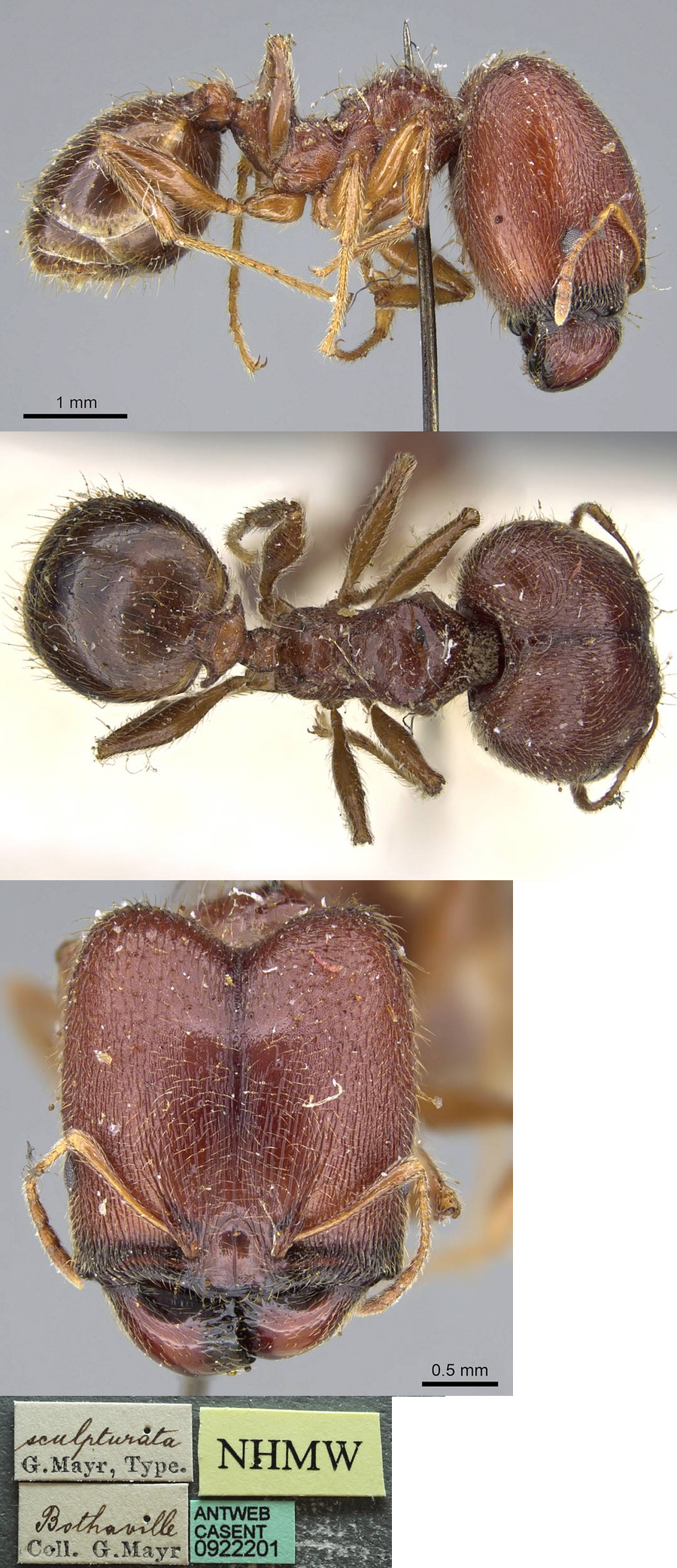 The photomontage
is of the type major collated from http://www.antweb.org/specimen.do?name=casent0922201. The photomontage
is of the type major collated from http://www.antweb.org/specimen.do?name=casent0922201.
There
is a puzzle here as Mayr (1866b) did not describe a minor worker. This
major and the minor below bear location labels as Bothaville, which is
where the Forel specimens, designated as areolata,
came from (also mentioned by Arnold, 1920a). Mayr gave the original
major as from "Caffernland", a historically ambiguous area which seems
likely not to include Bothaville.
|
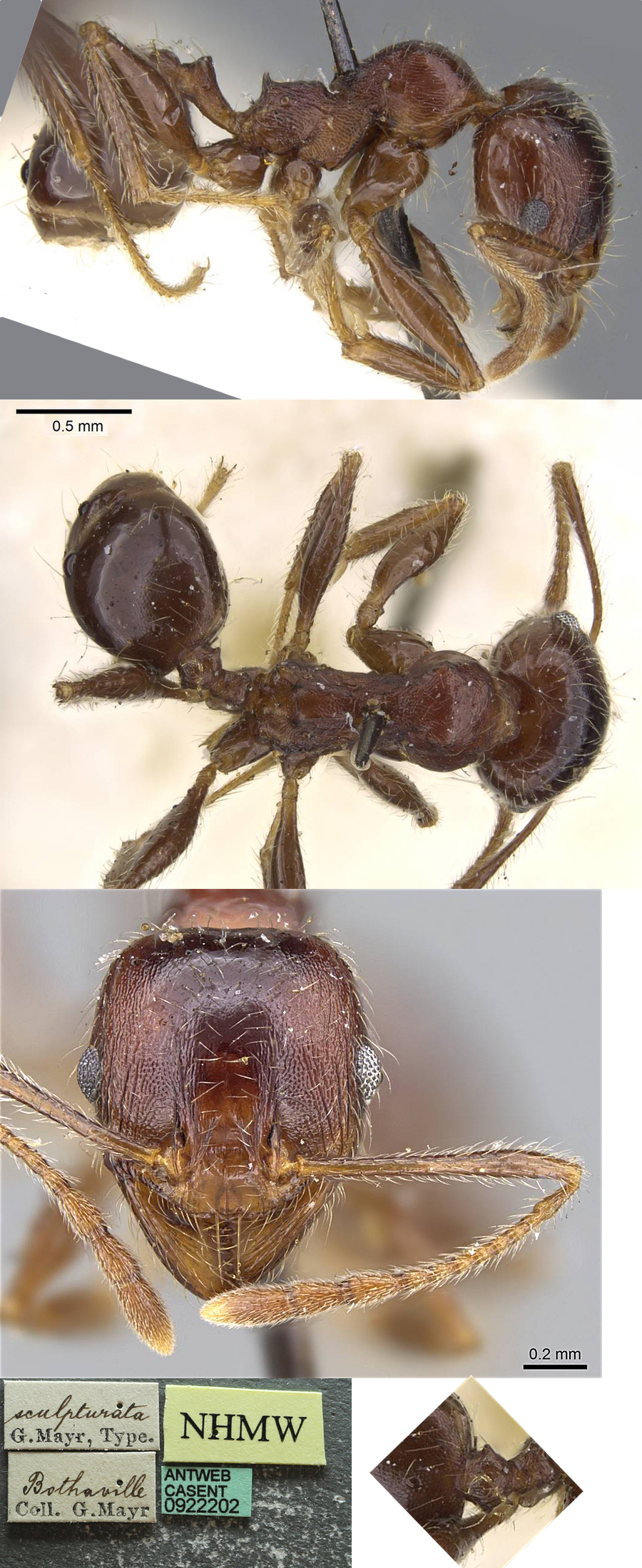 The photomontage
is of the type minor collated from http://www.antweb.org/specimen.do?name=casent0922202. The photomontage
is of the type minor collated from http://www.antweb.org/specimen.do?name=casent0922202.
Note the smooth frons and the small propodeal spines,
plus generally faint sculpture.
|
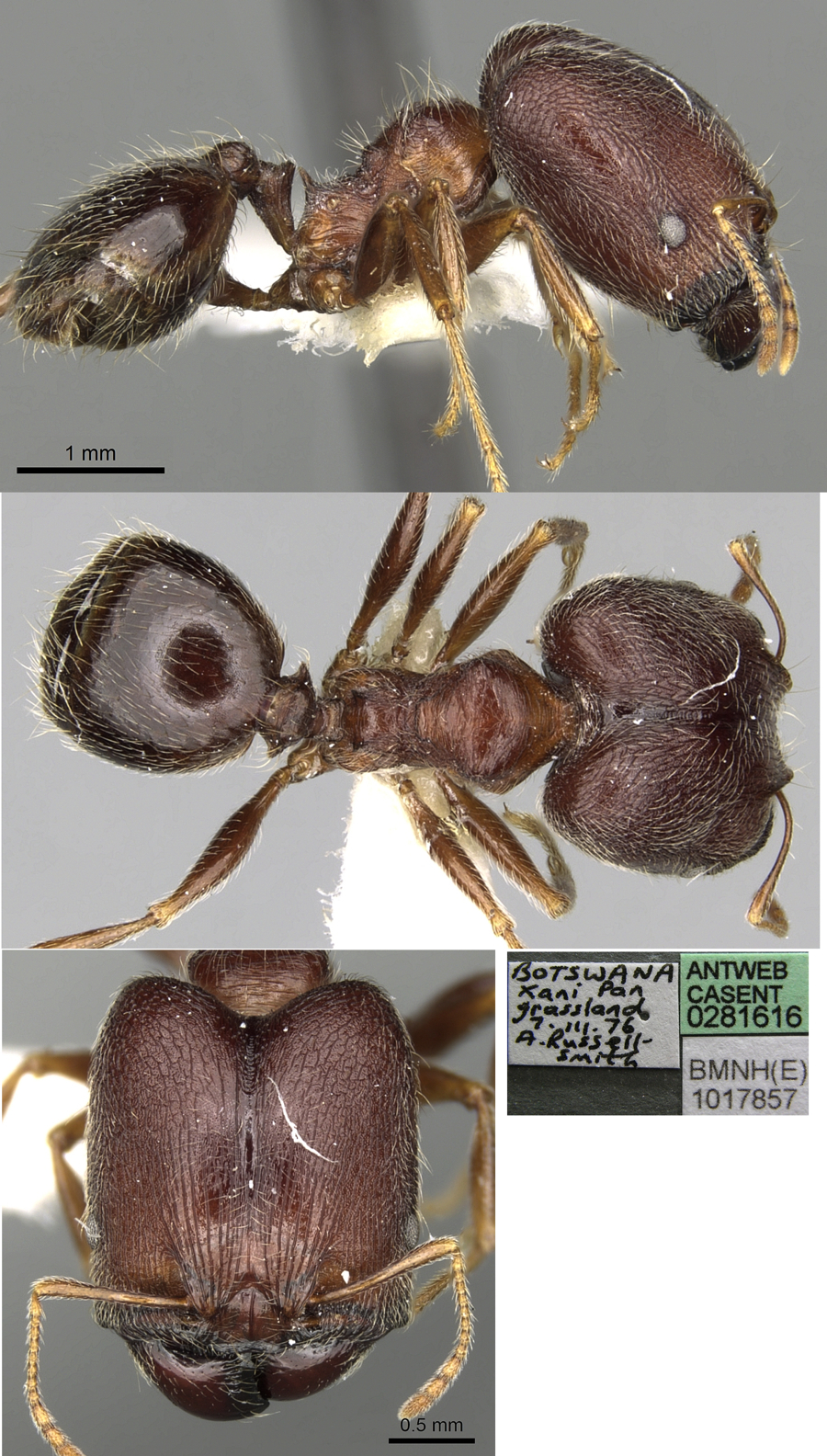 The photomontage
is of a major from Botswana, identified by B Bolton, collated from http://www.antweb.org/specimen.do?name=casent0281616 The photomontage
is of a major from Botswana, identified by B Bolton, collated from http://www.antweb.org/specimen.do?name=casent0281616
|
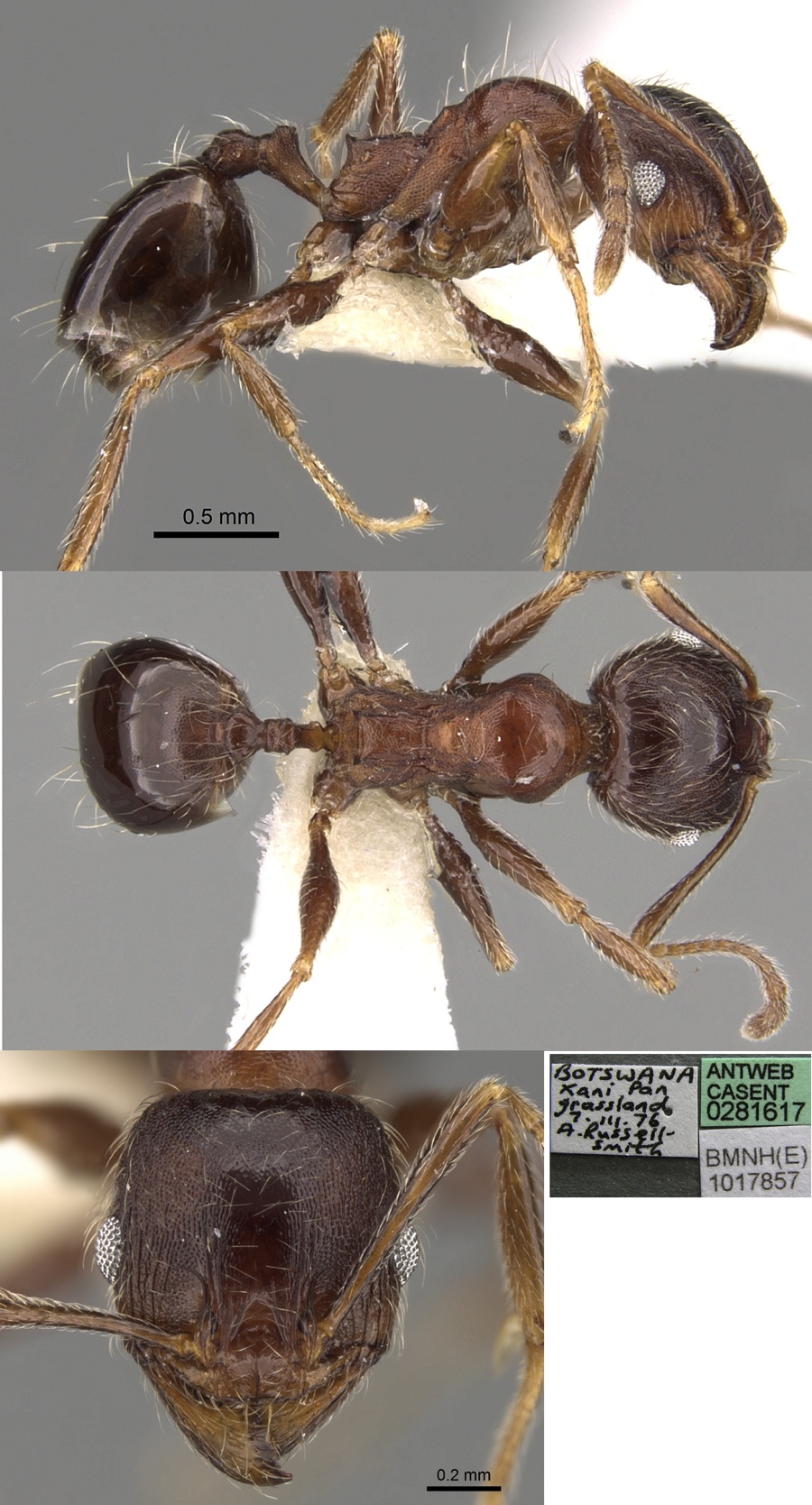 The photomontage
is of a minor from Botswana, identified by B Bolton, collated from http://www.antweb.org/specimen.do?name=casent0281617 The photomontage
is of a minor from Botswana, identified by B Bolton, collated from http://www.antweb.org/specimen.do?name=casent0281617
|
 The
photomontage
is of the areolata major,
collated from http://www.antweb.org/specimen.do?name=casent0249065 The
photomontage
is of the areolata major,
collated from http://www.antweb.org/specimen.do?name=casent0249065
Note
there is some error in the Antweb scales as the head appears to be some
120% wider in the full face view than the scale for the dorsal view
indicates. The location label Liberia is puzzling as the types were
from Bothaville, South Africa in Forel (1911e).
|
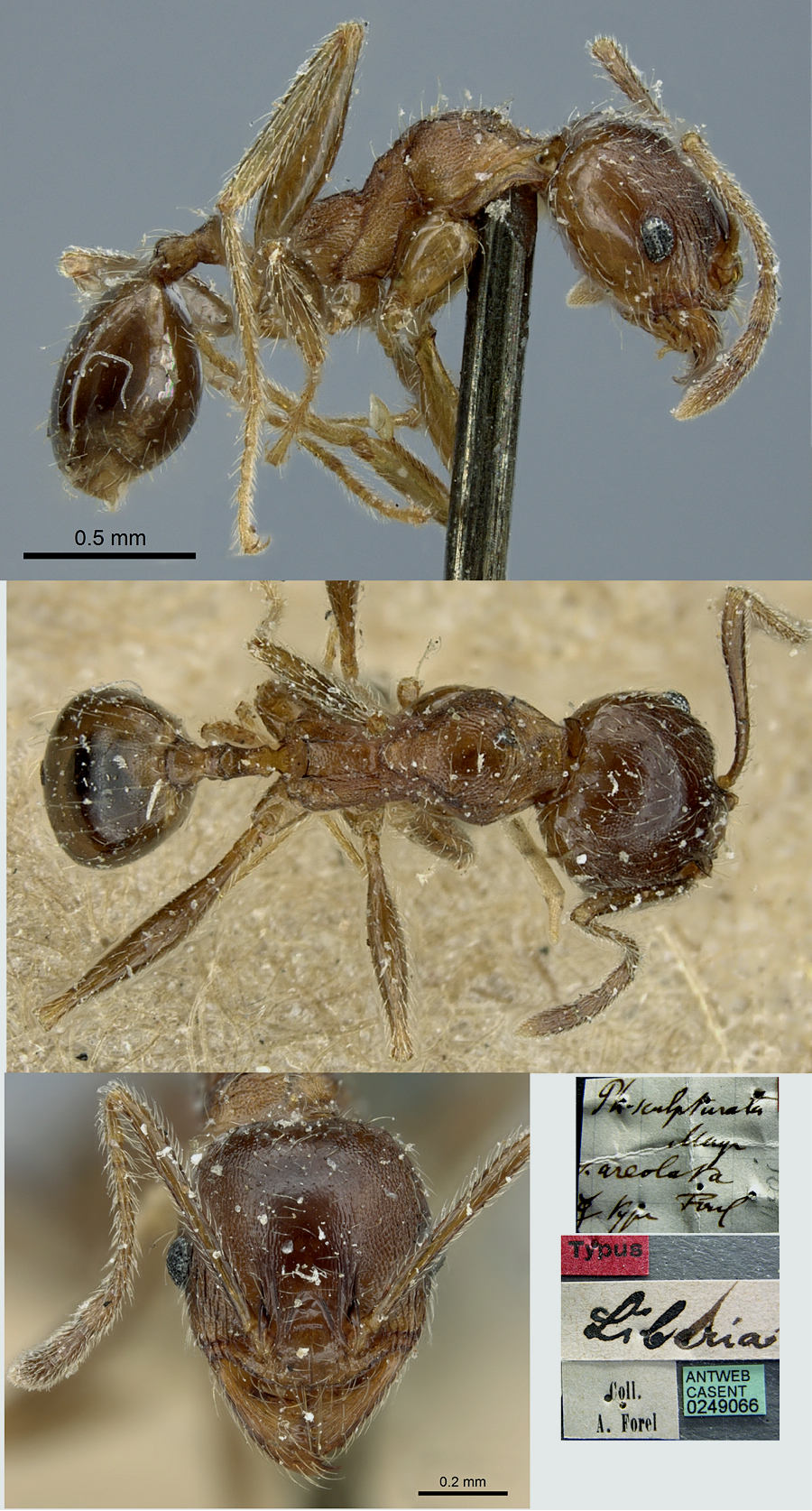 The photomontage
is of the areolata minor,
collated from http://www.antweb.org/specimen.do?name=casent0249066 The photomontage
is of the areolata minor,
collated from http://www.antweb.org/specimen.do?name=casent0249066
|
 The photomontage of a
syntype
major worker of reddenburgensis
is
collated
from http://www.antweb.org/specimen.do?name=casent0901301. The photomontage of a
syntype
major worker of reddenburgensis
is
collated
from http://www.antweb.org/specimen.do?name=casent0901301.
TL ca 6.3 mm, HL 1.88, HW 1.72, SL 0.70, PW 0.8,
CI 92, SI 41.
This is unmistakeably a relative of Pheidole sculpturata, with its
distinctive postpetiole with elongated, back-curved processes when
viewed from above. It is almost identical to the form described as P. sculpturata areolata Forel
(1911e).
|
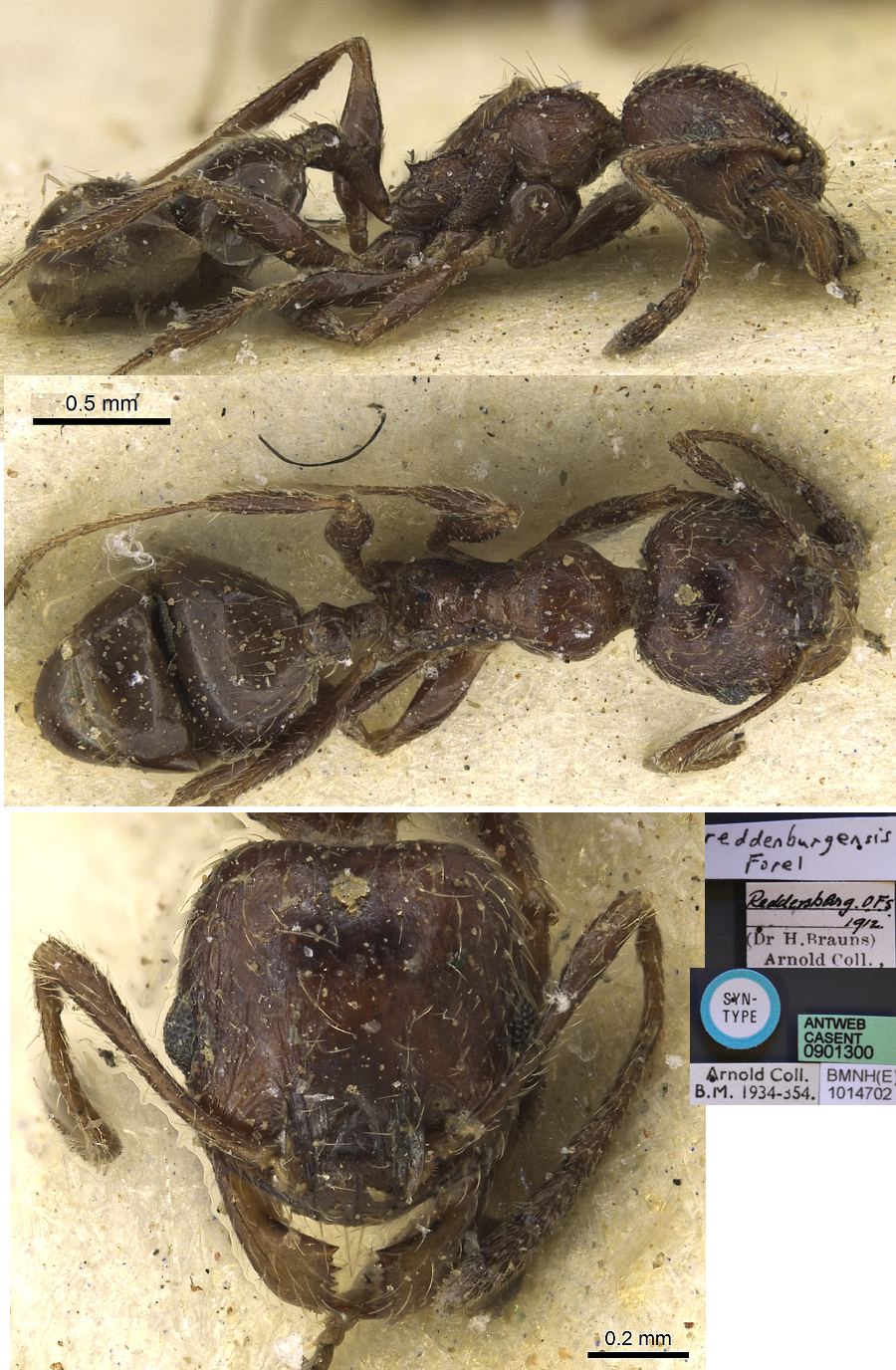 The photomontage of
a
syntype minor worker of reddenburgensis
is collated
from http://www.antweb.org/specimen.do?name=casent0901300. The photomontage of
a
syntype minor worker of reddenburgensis
is collated
from http://www.antweb.org/specimen.do?name=casent0901300.
TL ca 3.6, HL 0.71, HW 0.71, SL 0.57, PW 0.44, CI 100,
SI 82.
|
|